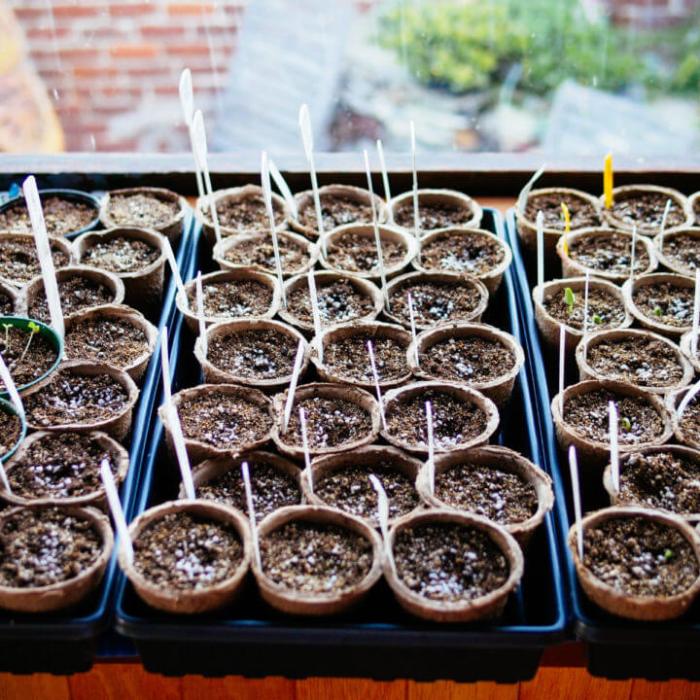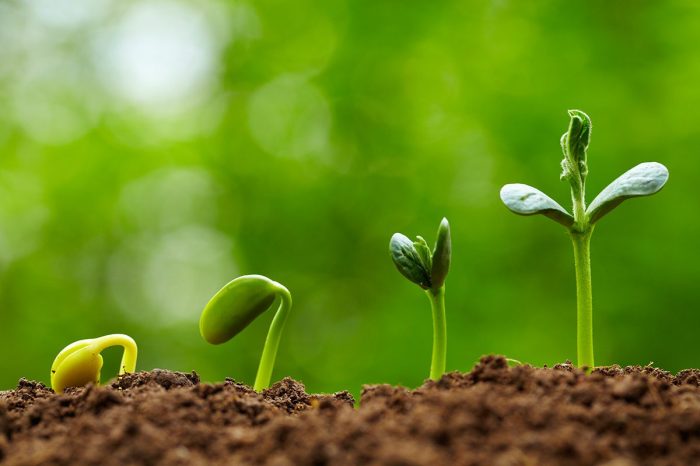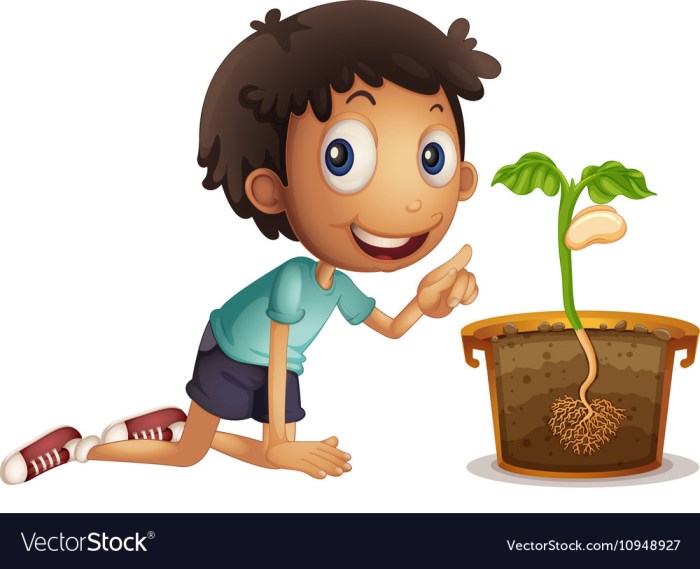How to Plant Seeds in a Pot
Choosing the Right Pot and Seed Starting Mix
How to plant seeds in a pot – Selecting the appropriate pot and seed starting mix is crucial for successful seed germination and healthy seedling development. The right pot size and material will provide adequate space and drainage, while a well-draining seed starting mix ensures proper aeration and moisture retention. Sterilizing both the pots and the mix helps prevent diseases and fungal growth, promoting healthy seedlings.
Ideal Pot Size and Material

Source: gardenbetty.com
The ideal pot size varies depending on the seed type and the plant’s mature size. Smaller seeds, like lettuce or herbs, can thrive in smaller pots (2-4 inches), while larger seeds, such as tomatoes or peppers, require larger pots (6-8 inches) to allow for sufficient root development. The material of the pot also impacts drainage and temperature regulation.
| Pot Material | Pros | Cons | Suitable Seed Types |
|---|---|---|---|
| Plastic | Lightweight, inexpensive, retains moisture well | Can overheat in direct sunlight, less breathable | Most seed types, especially those requiring consistent moisture |
| Terracotta | Breathable, helps regulate soil temperature, aesthetically pleasing | More expensive, dries out quickly, can be fragile | Seeds that prefer well-drained soil and don’t need constant moisture |
| Coco Coir Pots | Biodegradable, good moisture retention, excellent aeration | Can be more expensive than plastic, may require more frequent watering | Various seed types, especially those sensitive to overwatering |
| Peat Pots | Biodegradable, good moisture retention | Can dry out quickly, may break down quickly when transplanting | Most seed types, but must be careful not to overwater. |
Seed Starting Mix Characteristics and Homemade Recipe
A good seed starting mix should be light, airy, and well-draining to prevent damping off (a fungal disease that affects seedlings). It should also retain enough moisture to keep the seeds hydrated. Avoid using garden soil, as it can be too dense and contain pathogens.
Here’s a recipe for a homemade seed starting mix:
- 2 parts peat moss
- 1 part perlite
- 1 part vermiculite
Mix thoroughly until evenly combined. This mix provides excellent drainage and aeration.
Sterilizing Pots and Seed Starting Mix
Sterilizing prevents the spread of diseases and fungal infections. Pots can be sterilized by washing them thoroughly with soap and water, then rinsing them well. You can also sterilize them by soaking them in a 10% bleach solution (1 part bleach to 9 parts water) for 30 minutes, followed by thorough rinsing. The seed starting mix can be sterilized by microwaving it in a damp paper bag for several minutes, until it is thoroughly heated.
Allow the mix to cool completely before using.
Selecting and Preparing Seeds
Seed viability and germination rate significantly influence the success of your seed-starting efforts. Proper seed preparation techniques can improve germination rates and hasten the growth process. Understanding common mistakes helps prevent setbacks and ensures a higher success rate.
Seed Viability and Germination Rates
Seed viability refers to the ability of a seed to germinate and grow into a healthy plant. Germination rate is the percentage of seeds that successfully germinate under optimal conditions. To test seed viability, soak a few seeds in water for 24 hours. Seeds that sink are likely viable, while those that float are probably not.
Seed Preparation Techniques
Some seeds require pre-treatment to improve germination. Scarification involves breaking or weakening the seed coat to allow water and oxygen to penetrate. Soaking involves immersing seeds in water to soften the seed coat and promote faster germination.
- Scarification: Suitable for seeds with hard seed coats, such as beans, peas, and some wildflowers. Methods include gently filing or nicking the seed coat with a file or sandpaper.
- Soaking: Beneficial for seeds with hard seed coats or those that require a period of imbibition, such as tomatoes, peppers, and many herbs. Soak seeds in warm water for 12-24 hours before planting.
Common Seed Starting Mistakes

Source: microdrips.com
- Planting seeds too deep: This can prevent germination. Plant seeds at the appropriate depth, generally 2-3 times the seed’s diameter.
- Overwatering: This can lead to root rot. Water only when the soil is dry to the touch.
- Using the wrong type of soil: Use a seed-starting mix, not garden soil.
- Not providing enough light: Seedlings need adequate light for healthy growth.
- Ignoring temperature requirements: Maintain appropriate temperatures for germination and growth.
Sowing Seeds
The correct planting depth and spacing between seeds are critical for optimal germination and seedling development. Proper covering and watering techniques ensure the seeds receive the necessary moisture for germination without risk of rot.
Correct Planting Depth
The depth at which you plant seeds depends on their size. Generally, plant seeds at a depth of 2-3 times their diameter. After planting, the seed should be barely covered with soil. For example, tiny seeds like lettuce should be barely covered, while larger seeds like beans should be planted deeper.
Proper Spacing Between Seeds
Overcrowding leads to competition for resources, resulting in weak and leggy seedlings. Space seeds according to their mature size and the size of the pot. Refer to seed packets for recommended spacing. For example, larger plants such as tomatoes need more space than smaller plants such as lettuce.
Covering Seeds and Watering
Gently cover the seeds with soil after planting. Use a fine-mesh sieve to distribute the soil evenly and avoid burying seeds too deeply. Lightly water the soil after sowing, ensuring the soil is evenly moistened but not soggy. Avoid overwatering, which can lead to seed rot.
Planting seeds in a pot is generally straightforward: choose a suitable pot, add well-draining soil, and plant your seeds at the appropriate depth. For larger seeds, like those of a jackfruit tree, the process is similar, but requires more attention to space and soil nutrients. If you’re interested in growing your own jackfruit, check out this guide on how to plant jackfruit tree from seed for detailed instructions.
Once established, caring for your potted seedlings involves regular watering and sunlight exposure, ensuring healthy growth.
Providing Optimal Growing Conditions
Sunlight, temperature, and moisture are essential for successful seed germination and seedling growth. Grow lights can supplement natural light, while a consistent watering schedule prevents both underwatering and overwatering. Maintaining appropriate humidity levels helps prevent wilting and ensures healthy growth.
Sunlight and Temperature
Most seeds need ample sunlight (at least 6-8 hours per day) for germination and growth. Place pots near a sunny window or use grow lights to supplement sunlight, especially during winter months. Grow lights should be placed a few inches above the seedlings and adjusted as they grow taller. Ideal temperatures for germination vary depending on the seed type; check seed packets for specific requirements.
Watering Schedule
Water seedlings when the top inch of soil feels dry to the touch. Avoid overwatering, which can lead to root rot and damping off. Signs of underwatering include wilting leaves and dry soil, while overwatering manifests as yellowing leaves and soggy soil. Adjust your watering schedule based on the type of pot, seed starting mix, and environmental conditions.
Humidity Domes or Plastic Wrap
Humidity domes or plastic wrap create a humid microclimate that helps prevent seedlings from drying out, especially for delicate seedlings. They should be removed once the seedlings have germinated and developed a few true leaves to prevent fungal growth.
Seedling Care and Transplanting

Source: vectorstock.com
Recognizing and addressing common seedling problems is crucial for healthy growth. Hardening off seedlings gradually acclimates them to outdoor conditions before transplanting. Proper transplanting techniques ensure minimal stress on the seedlings.
Common Seedling Problems and Solutions, How to plant seeds in a pot
| Problem | Solution |
|---|---|
| Damping-off (fungal disease) | Use sterile soil and pots; ensure good air circulation; avoid overwatering. |
| Leggy seedlings (weak stems) | Provide more light; reduce watering slightly. |
| Yellowing leaves | Check for overwatering or underwatering; ensure adequate nutrients. |
| Wilting | Check for underwatering or pest infestations. |
Hardening Off Seedlings
Hardening off gradually acclimates seedlings to outdoor conditions. Start by placing seedlings outdoors for a short period (an hour or two) each day, gradually increasing the duration over several days. Protect them from direct sunlight and wind during the initial stages.
Transplanting Seedlings
- Gently remove seedlings from their pots, taking care not to damage the roots.
- Prepare the new container or garden bed by loosening the soil.
- Plant seedlings at the same depth they were growing in their original pots.
- Gently firm the soil around the base of the seedlings.
- Water thoroughly after transplanting.
Specific Examples of Planting Different Seed Types
Planting methods vary depending on the seed type. Some seeds require darkness for germination, while others need specific soil conditions and watering schedules. Knowing the optimal planting time ensures successful germination and healthy growth.
Planting Methods for Different Seed Types
| Seed Type | Pot Size (inches) | Soil Type | Planting Depth (inches) | Watering Needs |
|---|---|---|---|---|
| Basil (herb) | 4-6 | Well-draining seed starting mix | 1/4 | Keep consistently moist |
| Tomato (vegetable) | 6-8 | Well-draining seed starting mix | 1/2 | Water when top inch of soil is dry |
| Sunflower (flower) | 4-6 | Well-draining seed starting mix | 1/2 – 1 | Water when top inch of soil is dry |
Seeds Requiring Darkness
Some seeds, like lettuce and many wildflowers, require darkness for germination. Cover these seeds with a layer of soil or use a dark container to prevent light from reaching them during the initial stages of germination.
Best Time to Start Seeds Indoors
The best time to start seeds indoors varies depending on the plant type and your local climate. Check seed packets for specific recommendations or consult online resources for your region’s planting calendar. Generally, seeds for plants with a long growing season should be started earlier indoors, while those with shorter growing seasons can be started later.
FAQ: How To Plant Seeds In A Pot
What if my seeds don’t germinate?
Several factors can affect germination. Check seed viability, ensure proper planting depth and moisture levels, and verify optimal temperature and light conditions. Some seeds require scarification or stratification.
How often should I water my seedlings?
Water when the top inch of soil feels dry to the touch. Avoid overwatering, which can lead to damping off. The frequency depends on factors like pot size, soil type, and environmental conditions.
What are the signs of overwatering?
Signs of overwatering include wilting, yellowing leaves, and mushy stems. The soil will be consistently soggy.
What should I do if my seedlings are leggy?
Leggy seedlings result from insufficient light. Move them closer to a light source or supplement with grow lights.





















